






































Midweek Update 9 FEBRUARY 2023
Compiled by Willie Bodenstein
Google Banner Ad
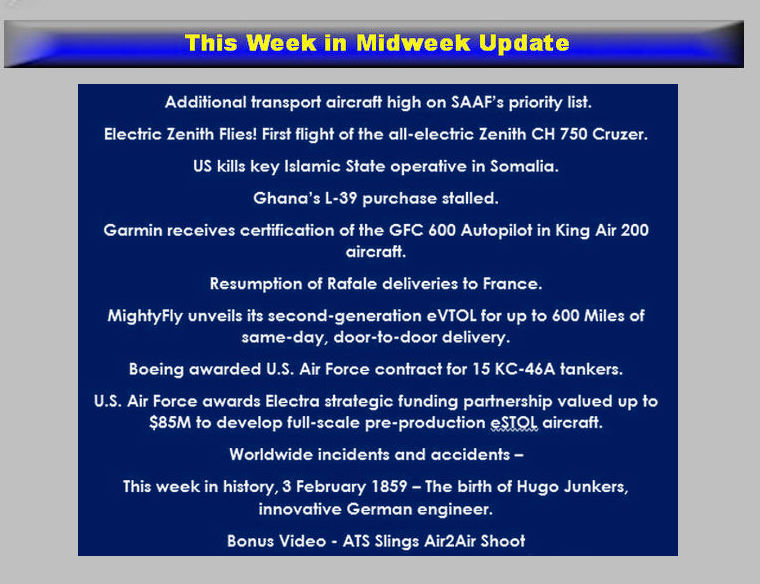



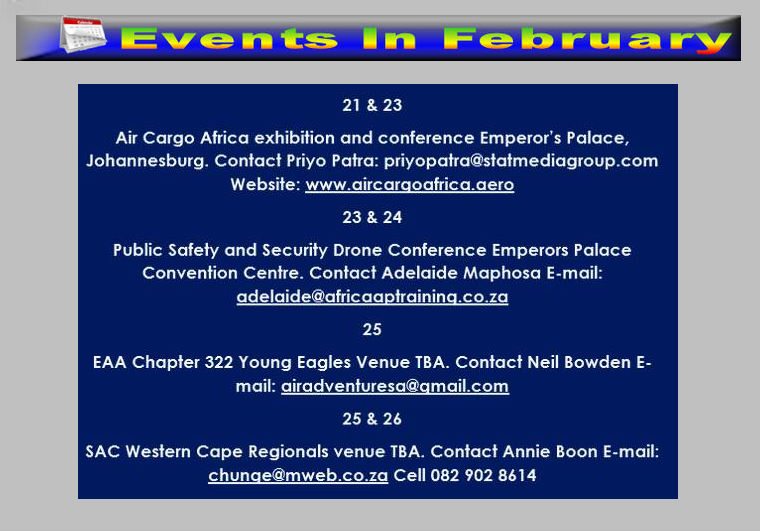

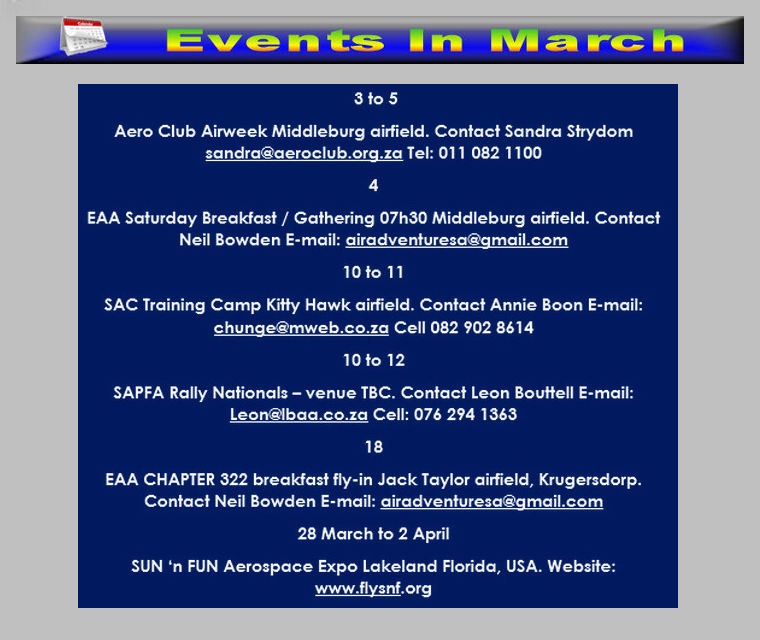

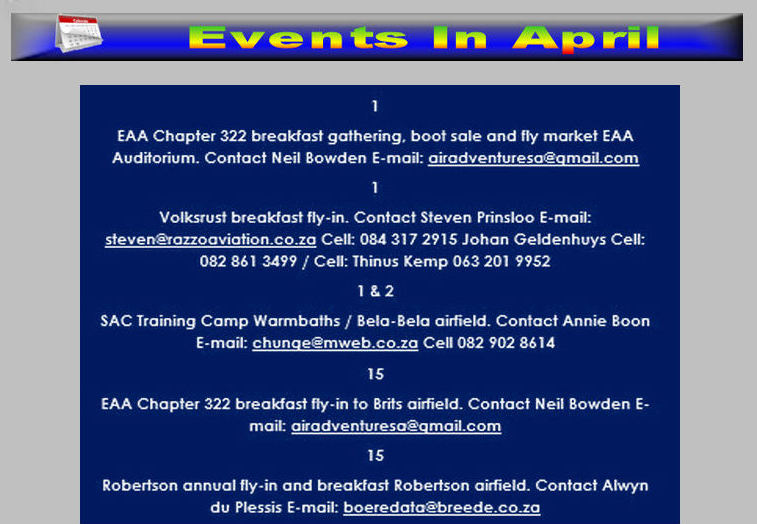
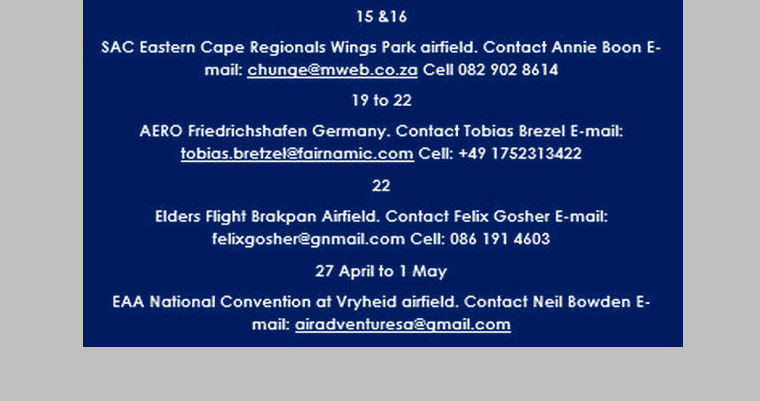


ADDITIONAL TRANSPORT AIRCRAFT HIGH ON SAAF'S PRIORITY LIST
Guy Martin defenceWeb

Medium and strategic airlift are at the centre of the South African Air Force's (SAAF's) attention due to its commitments on the African continent, Chief of the SAAF Lieutenant General Wiseman Mbambo has said.
In mid-2022, the South African Department of Defence revealed that it was exploring upgrading the C-130BZ Hercules fleet of five airworthy aircraft plus one in storage at a cost of R1.6 billion, as the fleet only has a couple more years of life in it before upgrades are needed.
Mbambo, in response to a defenceWeb question on acquiring additional C-130s, said “in our road going forward, the medium lift capability is right in the centre of our attention. Also, there is a lot of talk around the strategic lift capability. This is not a surprise as to why this capability is being mentioned. The reality we face is South Africa is not in a strategic position. Our location cannot be changed. We need to have very strong legs to connect ourselves to the rest of the continent and the world.”
Mbambo, speaking to the media following the SAAF's Prestige Day Parade at Air Force Base Swartkop on 27 January to celebrate the force's 103rd anniversary, said the transport capability is very important in terms of C-130s and, going forward, strategic lift, especially if South Africa has its troops moving up and down the continent. At present, the National Defence Force has troops deployed in the Democratic Republic of Congo and Mozambique.
Mbambo added that National Treasury “is warming up” towards funding medium and strategic lift, and “that is very very, very good.”
Mbambo indicated the SAAF is still deciding whether to fund the upgrade of the current C-130BZs, as funding is needed to get a number of them flyable, or accepting donated C-130Hs that will also require funding to upgrade.
With regard to the Gripen fleet, a maintenance contract with Saab was signed last year, allowing a couple of aircraft to return to the air and fly at the Africa Aerospace and Defence exhibition in September, but defenceWeb understands an engine support contract with GKN has yet to be signed. No Gripens took part in the SAAF's Prestige Day Parade flypast, but Mbambo is confident two Gripens will be made available for Armed Forces Day on 21 February.
Mbambo said the SAAF plans to have 13 Gripens back in the air, as per the contract with Saab, but could not give a timeline on that.
The Chief of the SAAF made mention of the “serious issues” facing the Air Force, notably the chronic lack of funds. “This Air Force has tasted what greatness is and at the same time this Air Force has tasted what adversity is and what it is to live with limited funding.” Rebuilding capabilities is something the SAAF aims to do in order to return to its former glory and ensure it is “fully operational across different capability areas, so people have no doubt the Air Force is there.”
“The limitations are real and the constraints are real. If we can just switch to how we approach these problems and provide different solutions we can find a way going forward,” Mbambo said.
In his Prestige Day Parade speech, Mbambo said that “when a common pool from which everyone goes to for quenching their thirst is shrinking, nobody is spared from the consequent results. Our national pool - the South African economy - is currently not in a good shape. The snowball impact is felt everywhere including in the Department of Defence and equally in the South African Air Force. As this reality continues, the mandate of the Air Force to ensure South Africa's airspace territorial integrity still remains. Furthermore, the increased demand for air assets due to the upsurge of various security threats and disasters cannot be wished away.”
Mbambo quoted defence minister Thandi Modise, who last year said there is a widening dichotomy between that which the SANDF is expected to achieve and the resources that are provided to achieve these expectations.
Mbambo said the SAAF is looking at different approaches to deal with the problem of scarce resources. “Our continuous engagements withal key role players to bring Air Force capabilities to the required combat readiness status is persistent.”
The SAAF Chief mentioned that “we still believe that as the military organisation we must continue to grow our own timber.” He said, “we are going to accelerate the inhouse capabilities in the SAAF this year and beyond. Already there are visible seeds in certain areas which we shall unveil before the end of this year.”

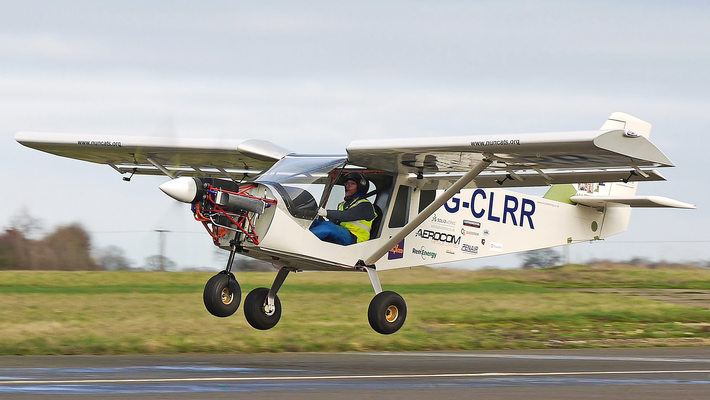
A pioneering UK aviation project aimed at bringing healthcare to some of the most remote parts of the world is a step closer to take-off after its first flight on 20 January 2023.
NUNCATS is developing the 'electric sky jeep', an all-electric Zenith CH 750 Cruzer with big tires, to provide sustainable transportation to deliver doctors, teachers and medical supplies to remote communities across the world.
The British community interest company plans to tap into ground-based networks of solar powered energy grids in remote towns and villages so that the aircraft can fly between villages delivering vital medical staff and supplies, without reliance on outside fuel (needing to be flown in).
The successful test flight is a significant step forward for the project, and an ongoing test program will continue to establish range, endurance, payload and performance figures in different battery/weight configurations.
Using the proven and popular Zenith CH 750 platform, the aircraft is well suited for "off-airport" operations, and can be flown in and out of much smaller (shorter) runways than typical general aviation aircraft, and often in "unimproved" (non-paved) runways such as grass or dirt landing fields.
NUNCATS is the brainchild of UK-based husband and wife team Tim and Helen Bridge who founded the company in 2019. Following the first flight, Tim Bridge, who has extensive experience in renewable electric energy projects, stated: “Nobody else is building electric aircraft in this way. Our aim is to provide a low-cost, rugged and practical aircraft for use in rural and hard to reach communities, such as medics in Uganda and doctors in rural India.
“As soon as funding allows, we hope to move towards getting this into communities where it can make a real difference. There are currently a billion people in the world with no access to healthcare...”
The Electrek article points out that NUNCATS still has a lot of work ahead "to achieve its goal of saving lives around the world through clean and nimble aviation. The project is still seeking backers and sponsors to help fund its development. The “electric sky jeep” kits can also be purchased as a greener option for sports flyers."
Quoted in Aerospace Testing International magazine following the maiden flight, test pilot Tim Kingsley stated, “I'm very happy with how today went. It was cold out there, there was a bit of crosswind, but everything went really well.
"I'm delighted to be involved in this project and although it is still at its very early stages the vision is a really exciting one. There's nothing like this anywhere else in the world.
“I've seen first-hand the challenges some of these communities face and harnessing natural energy in such a way could make a real difference to so many people's lives.” (Aerospace Testing International, 1/24/2023)
NUNCATS (No Unnecessary Novelty Community Air Transport) is a non-profit organization based in the United Kingdom (UK) that has been building an electric “sky jeep” for the last three years. They have partnered with kit manufacturer Zenith Aircraft Company and several start-up investors, and have taken an existing platform, the Zenith CH 750 Cruzer light sport aircraft design, and adapted it for all-electric operation.
"While we all know that today's battery technology will not permit the range and endurance available with ICE [internal combustion engines], there are some clear advantages of electric power in addition to the more obvious sustainability claims," explained Sebastien Heintz, president of Zenith Aircraft Company. "The simplicity of electric motors has the potential to make light aircraft propulsion systems more reliable and easier to install and maintain (especially important for amateur aircraft builders and owners), and near-instantly available torque of electric power can further improve upon the STOL (short take-off and landing) performance of Zenith kit aircraft designs."
"Furthermore, projects like NUNCATS demonstrate that forward-thinking innovation finds new uses and applications by combining these technologies [airframe design, electric propulsion and ground based solar charge stations] to address real needs around the world in ways that have not been possible before. Zenith aircraft are designed to be simple and reliable, very affordable, and for great short off-airport (STOL) capability. We're thrilled to see the proven Zenith designs being used for this, and anticipate that amateur kit builders will soon be able to access this technology for their light aircraft projects, here and around the world."
Last year NUNCATS also teamed-up with UK air charter company SaxonAir, the International Aviation Academy Norwich, Action Community Enterprises (ACE), East Coast College and Vattenfall to give young people (aged 16 to 25) the opportunity to start building an aircraft (from a Zenith kit) at a free STEM aviation summer school. The youth-built aircraft will become their second flight-ready 'electric sky jeep' while also providing an excellent hands-on learning opportunity to the youth aircraft builders.
NUNCATS has publicly announced today that it has received funding from the UK Civil Aviation Authority's “Reach for the Skies Challenge Fund” to establish STEM facilities at Old Buckenham Airfield and to continue the student led build of the summer-school aircraft that was started last year. A two-seat Zenith CH 750, the plane will be completed as the second of the electric sky jeeps, based on the prototype now being flight tested.

Pearl Matibe
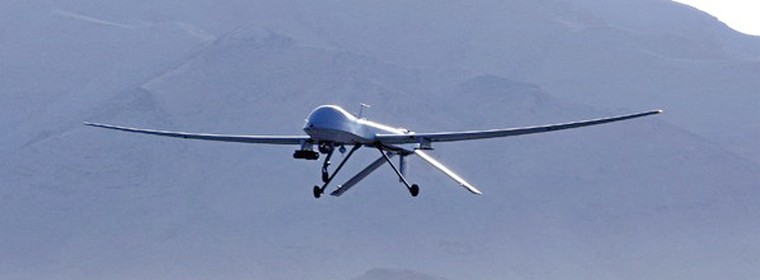
In a major counterterrorism operation carried out on orders from President Joseph Biden, the US military conducted a precision strike on a mountainous cave complex in northern Somalia. The operation resulted in the death of key ISIS operative Bilal al-Sudani and several other ISIS affiliates.
According to a senior administration official, the US had prepared for the possibility of capturing al-Sudani but the hostile response from Islamic State forces led to his death on 25 January.
President Biden was thoroughly briefed on the intelligence, planning, and risks involved in the operation by the Department of Defence. After careful consideration and consultation with his national security team, the President authorized the operation, US officials said.
The US assessed al-Sudani of providing funding to support the operational capabilities of ISIS elements around the world, including its core branch in Afghanistan. The United States' preference was to pursue capture operations, but in this case, it was not feasible, the senior administration official stated.
“This precision operation took place in a mountainous cave complex in northern Somalia. Thankfully, and based on extensive planning and exquisite execution of the plan, there were no casualties among American servicemembers or civilians,” the official said.
The US military's Africa Command (AFRICOM) has been conducting operations in support of the Somali National Army against Al-Shabaab. In the past week, there have been at least three airstrikes carried out, all in remote areas where Somali forces were conducting operations. AFRICOM said it is providing training, advising, and equipping to the Somali forces to defeat Al-Shabaab.

Guy Martin defenceWeb
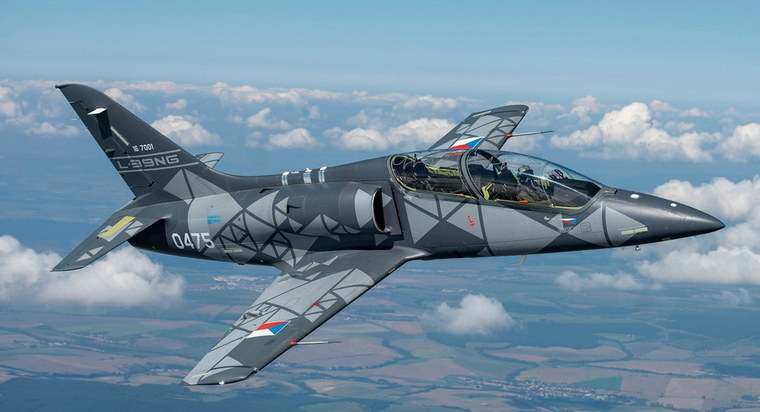
Ghana's plan to acquire half a dozen L-39NG light combat jets from Aero Vodochody has stalled, with a lack of funds putting the €111 million deal on ice.
In August 2021, Ghana's defence minister, Dominic Nitiwul, sought parliamentary approval for the €111 million procurement of six L-39NG aircraft along with spares, training and support. The aircraft were to be acquired through a loan agreement.
At the time, Aero Vodochody said it was negotiating with the Ghanaian Ministry of Defence for the supply of the aircraft but could not comment further. Six months later, negotiations were still underway.
In January last year it was reported that the Ministry of Defence had suspended negotiations whilst a rival bid from the United States was evaluated. Ghana was offered two different aircraft by the US: the Embraer/Sierra Nevada A-29 Super Tucano and the AT-6C Wolverine made by Textron. Although the US offers were not taken up, Ghana's Parliament has still not endorsed the Czech purchase almost a year later.
It is believed that budgetary constraints have stalled the procurement in spite of a September 2022 visit to Aero Vodochody by Thomas Mbomba, Deputy Minister of Foreign Affairs, and Ambassador James Nyasembi from Ghana.
Ghana's L-39NG acquisition may go the same way as Senegal's. In April 2018 it was announced that Senegal would be acquiring four L-39NGs, but in early 2022 it emerged that the deal had been cancelled after a number of setbacks.
Ghana previously operated eight Aero L-29 Delfin trainers and two L-39ZO ground attack aircraft but today flies four Hongdu K-8 advanced jet trainer aircraft and five Embraer EMB 314 Super Tucano light attack aircraft.
The L-39NG is the latest iteration of the successful L-39 Albatros trainer. The L-39NG programme started in 2014, with four prototypes being produced. Serial production began in December 2022.
The L-39NG is powered by a single Williams FJ44-4M engine with FADEC control and has five hardpoints for 1 200 kg of weapons (three more than previously). Due to a more efficient engine and reduced drag, range is increased by 800 km to 1 900 km. Other changes compared to the standard L-39 are wet wings without wingtip tanks, a 15 000-flight hour service life, lighter and stronger airframe and Health and Usage Monitoring System. The L-39NG uses 50% new parts.
Ghana has since 2017 made use of Czech company LOM Praha for the maintenance of its Mi-17, Mi-171Sh and Mi-8 helicopters and has interacted with other Czech defence companies. A memorandum of understanding on defence cooperation was signed between Ghana and the Czech Republic in 2021. Czech defence industry delegations have in recent years visited Ghana, Burkina Faso, and Togo, where companies such as Aero Vodochody, LOM Praha, Excalibur Army, SVOS, European Air services, and Transcon have offered their products and services.

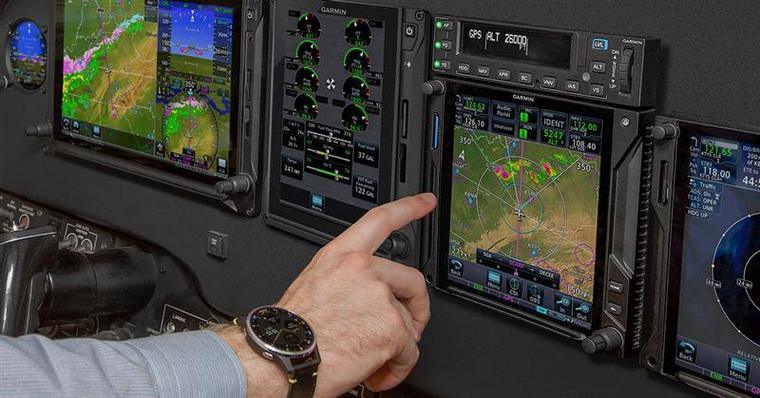
Garmin has announced it has received Federal Aviation Administration (FAA) Supplemental Type Certification (STC) for the GFC™ 600 autopilot in the King Air 200 series of aircraft. The GFC 600 digital autopilot is designed for high performance piston single and twin-engine aircraft, and also provides an advanced autopilot solution for both jet and turbine aircraft that have a wide range of speed and performance characteristics.
The GFC 600 certification for the King Air 200 provides owners an autopilot upgrade that incorporates solid-state attitude with robust self-monitoring capabilities to provide superior autopilot performance, greater reliability and safety features that are similar to the popular GFC 700 autopilot. In addition to traditional autopilot capabilities such as altitude hold, vertical speed and heading modes, the GFC 600 also includes altitude preselect, VNAV1, Level Mode, underspeed and overspeed protection and more. Pilots can also select, couple and fly various instrument approaches, including GPS, ILS, VOR, LOC and back course approaches when paired with a compatible GPS navigator.
Environmentally hardened autopilot servos designed for harsh operating conditions contain brushless DC motors offering improved performance and reducing maintenance requirements when compared to decades-old servo designs on the market today. In addition, these servos are optimized for turbine aircraft by offering more torque to help better command and respond to control demands required of turbine aircraft.
Standard mark-width (6.25-inch) design of the GFC 600 mode controller ensures the autopilot controller allows for routine installation into the aircraft's avionics stack. In King Air 200 aircraft, GFC 600 will require a G600 TXi or G600 flight display.
In addition to traditional autopilot capabilities, the GFC 600 offers:
Reduced pilot workload with coupled 'go-arounds' during missed approaches when properly equipped.
Premium functions and advanced capabilities such as altitude pre-select2 and indicated airspeed hold mode.
Built-in GPS roll steering capability that eliminates the need for external roll steering converters, allowing for smoother navigation when installed with a compatible navigator.
Level Mode button, which automatically engages the autopilot to restore the aircraft to straight and level flight.
Underspeed protection can help prevent the pilot from stalling the aircraft.
Overspeed protection which can help prevent the pilot from exceeding the aircraft maximum speed (VNE).
Yaw Damping (YD) mode that can help minimize yawing oscillations and can also help to maintain coordinated flight.
Flight Director command bars that can be displayed on the G600 and G600 TXi flight displays.
Control wheel steering that allows the pilot to adjust pitch, roll, altitude hold, vertical speed or airspeed references using the control yoke while the autopilot is engaged.
As a standard feature, pilots receive Garmin Electronic Stability and Protection (ESP™) with the GFC 600 digital autopilot, which works to assist the pilot in maintaining the aircraft in a stable flight condition. ESP functions independently of the autopilot and works in the background to help pilots avoid inadvertent flight attitudes or bank angles and can help provide airspeed protection while the pilot is hand-flying the aircraft.
The GFC 600 digital autopilot for the King Air 200 is available immediately through select Garmin authorized dealers for the following variants: 200, 200C, A200, A200CT, B200, B200C, B200GT. Garmin continues to add additional aircraft models to the growing STC list for the GFC 600 autopilot. To view the most up-to-date aircraft STC list, including certifications that are expected to begin in the next 12 months, or to express interest in a specific aircraft make/model, visit www.garmin.com/GFC600

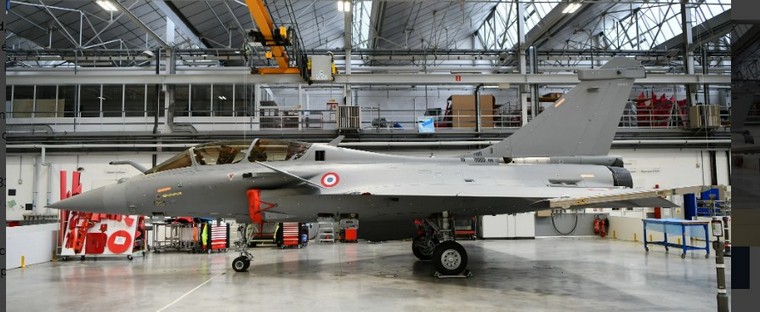
On 29 December 2022, Dassault Aviation's Mérignac plant delivered Rafale B359 (F3R standard) to the Direction Générale de l'Armement (French defence procurement agency). This event marks the resumption of Rafale deliveries to France after an interruption of four years.
The Rafale B359 is for the French Air and Space Force. It is part of the “tranche 4” order for 60 aircraft awarded in 2009.
In accordance with the various Military Programming Acts, deliveries to France were interrupted for budgetary reasons.
The Rafale production line was then dedicated to export orders.
A further 27 Rafale are still to be delivered for tranche 4, plus 12 Rafale ordered by France in 2021 to make up for the 12 aircraft sold to Greece.
Tranche 5 should be awarded in 2023.
In the current strategic context, the Dassault Aviation group is particularly proud to be a partner in equipping and supporting the French air force, as it has done for more than a century.
Ninety-two export Rafale were ordered (80 United Arab Emirates, 6 Greece, 6 Indonesia), compared to 49 (37 Export and 12 France) in 2021. As of December 31st 2022, the backlog includes: • 164 Rafale compared to 86 Rafale as of 31 December 2021.
With over 10,000 military and civil aircraft (including 2,500 Falcons) delivered in more than 90 countries over the last century, Dassault Aviation has built up expertise recognized worldwide in the design, development, sale and support of all types of aircraft, ranging from the Rafale fighter, to the high-end Falcon family of business jets, military drones and space systems. In 2021, Dassault Aviation reported revenues of €7.2 billion. The company has 12,400 employees.
.jpg)
Just 21 months after receiving $5.1 million seed funding and with only nine months from concept to first flight, MightyFly is unveiling the next generation of its aircraft, the MightyFly Cento. The Cento is a hybrid, electric Vertical Take-off and Landing (VTOL) aircraft with a cargo capacity of 100 lbs (45 kg), a range of 600 miles (965 km) and a max speed of 150 mph (240 km/hr).
The Cento is equipped with a 6 ft by 1 ft by 1 ft (1.8 m by 0.30 m by 0.30 m) internal cargo bay able to carry 96 small USPS packages. Cargo is loaded and unloaded by a conveyor belt that operates autonomously.
Because the Cento is equipped with a hybrid powertrain, it does not require recharging between flights. An internal combustion engine recharges the aircraft's battery while in the air, enabling it to perform multiple consecutive deliveries.
"The traditional hub-and-spoke distribution model doesn't serve everyone," said Manal Habib, MightyFly CEO and co-founder. "We need to be able to adapt to various cargo volumes and expedited timing. Medical companies, just-in-time manufacturing and retailers that now provide same-day delivery need a faster and more affordable way to get their goods and perishables to the final destination."
The Federal Aviation Administration (FAA) has granted the MightyFly Cento a Special Airworthiness Certificate and a Certificate of Authorization (COA) for long-range flights. This allows the company to operate in a larger airspace (230 square miles) to test the transition from hover to forward flight at medium and high altitudes (up to 5,000 feet).

The U.S. Air Force has awarded Boeing [NYSE: BA] a $2.3 billion contract for the ninth production lot of 15 KC-46A Pegasus tanker aircraft, expanding its fleet of the world's most advanced multi-mission aerial refueler. To date, 128 KC-46A Pegasus are on contract with the U.S. Air Force, with 68 delivered and operationally deployed worldwide.
“The combat-ready KC-46A is transforming the role of the tanker for the 21st century,” said James Burgess, vice president and KC-46 program manager. “We're proud to work side-by-side with the Air Force ensuring the Pegasus provides unmatched capabilities and continues to evolve for the U.S. and its allies' global mission needs.”
The KC-46A Pegasus delivers crucial fuel and data for the fleet, as well as cargo, personnel and aeromedical transportation for joint force rapid mobility, global reach and agile combat employment.
Last year, the U.S. Air Force Air Mobility Command approved the KC-46A for global operations including combat deployment. The Pegasus continues to demonstrate its agile combat employment capabilities, recently completing a 42-hour endurance flight supporting a U.S. Air Force Bomber Task Force mission in the Indo-Pacific region.
During 2022, KC-46A aircraft operating in a series of U.S. Air Force global employment exercises in the European theatre, Indo-Pacific region and the Middle East performed at a greater than 95% mission capable rate, demonstrating the aircraft's reliability and combat readiness.
Boeing builds KC-46A aircraft on the 767-production line in Everett, Wash., supported by a supplier network of about 37,000 American workers employed by more than 650 businesses throughout more than 40 U.S. states. With Boeing's in-line production, the KC-46A is designed and built as a tanker from day one - not a post-production conversion - making the Pegasus uniquely suited to integrate advanced technology for fleet data connectivity and combat-ready defensive features, as well as new capabilities as the needs of the mission evolve.
Boeing is on contract for 138 KC-46A Pegasus tankers globally. Boeing has delivered two of six KC-46A tankers to the Japan Air Self-Defence Force, and is on contract for four KC-46A tankers for the Israel Air Force. The expanding global fleet creates commonality and interoperability efficiencies and mission-readiness advantages for the U.S. Air Force and allies.

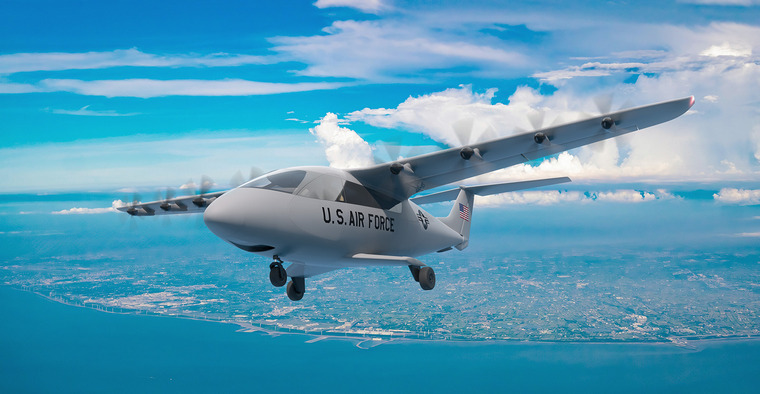
Electra, a next-gen aerospace company with a mission to help decarbonize aviation and open new air transportation markets, announced its selection by the U.S. Air Force AFWERX innovation arm for a Strategic Funding Increase (STRATFI) award that secures up to $85 million between private investments, government funding, and matching Small Business Innovation Research (SBIR) funding for Electra's development of a full-scale pre-production prototype electric short take-off and landing (eSTOL) aircraft.
This STRATFI award secures an investment partnership that funds the rapid development, test, and evaluation of a full-scale pre-production prototype eSTOL aircraft which can be used by the Air Force to validate requirements and operational use cases. It will leverage Electra's upcoming world-first flight test of a two-seat piloted eSTOL technology demonstrator aircraft and substantially accelerates the transition path for Electra's commercial nine-passenger eSTOL product aircraft to support Air Force missions of interest.
This effort builds directly from Electra's six active USAF SBIR and Small Business Technology Transfer (STTR) Phase II and Phase III contracts which have matured each of the core aspects of eSTOL technology - distributed electric propulsion, blown lift aerodynamics and acoustics, precision flight controls and hybrid-electric powertrains. Under the STRATFI contract, Electra will further strengthen its partnership with the AFWERX Agility Prime program, chartered with expanding technology transition paths to accelerate emerging dual-use markets by leveraging government resources for rapid and affordable fielding, while bolstering U.S. tech advantage.
“This STRATFI award reinforces the Air Force's commitment to dual-use eSTOL technology as a solution for national security and other government missions and validates Electra's aircraft design and engineering work to date,” said John S. Langford, Founder and CEO of Electra. “The cost and risk advantages of eSTOL technology also make it a smart investment. We are honoured to be chosen for this significant award and look forward to continuing our close collaboration with the Agility Prime team.”
“There is a significant gap in the Joint Force to provide logistics and sustainment to widely dispersed units across large contested geographical areas at the tactical edge,” said Ben Marchionna, Electra's Director of Technology and Business Development. “Electra's eSTOL is ideally suited to serve as a small highly fuel-efficient airlifter that helps the Air Force execute its Agile Combat Employment doctrine and meet its operational energy goals to reduce aviation carbon emissions. Small, affordable, runway-independent eSTOL aircraft could also alleviate demand on larger, few-in-number, high performance fixed wing and rotorcraft platforms in a contested logistics environment. Our team is thrilled to help the Air Force solve this key national security priority.”
“It's vital that we ensure new advanced air mobility technologies with dual-use applications are developed and manufactured here at home in the U.S.,” said Lieutenant Colonel John “Wasp” Tekell, Air Force Agility Prime Lead. “Electra's eSTOL technology has the potential to deliver valuable logistics and mobility capabilities to the Air Force. We value our partnership with Electra and look forward to supporting their continued development and future transition.”

NEAR SYLACAUGA, AL - USA
On 28 January 2023, at 1751 central standard time, an Aero Commander 500B, N107DF, was substantially damaged when it was involved in an accident near Sylacauga, Alabama. The pilot was seriously injured. The airplane was operated as a Title 14 Code of Federal Regulations Part 91 positioning flight.
According to the pilot, he flew a different airplane to the Tampa Executive Airport (VDF), Tampa, Florida, and intended to reposition the accident airplane, which was due for a 100-hour inspection, to Birmingham-Shuttlesworth International Airport (BHM), Birmingham, Alabama, for maintenance.
During the prefight inspection, the pilot turned on electrical power and noticed that the fuel gauge was reading 80 gallons of fuel. He walked into the fixed-base-operator (FBO) at VDF and requested that the airplane's fuel tanks be topped-off. A ramp technician reported that the fuel tanks were already full. The pilot subsequently removed the airplane's fuel cap, noticed fuel in the filler neck and assumed the fuel tanks were full. He did not push open the anti-siphon fuel valve to further confirm that the tanks were full.
According to the fueller at the FBO, she removed the airplane's single fuel cap and saw fuel on top of the anti-siphon valve. She used her finger to push down the valve and felt fuel, so she believed the airplane was full of fuel and did not need additional fuel.
The pilot completed the prefight inspection checklist and started the engines. He noticed the fuel gauge was flickering and thought it was malfunctioning. He proceeded to depart for BHM. After about 2 hours of flight-time, the airplane's right engine lost power and a few seconds later, the left engine lost power. He did not look at the fuel gauge during this time. He notified the air traffic controller of the loss of power to both engines and was vectored towards Merkel Field Sylacauga Municipal Airport (SCD), Sylacauga, Alabama. The airplane was unable to reach the runway and the pilot performed a landing in a cotton field. After landing, the airplane rolled into trees and the left wing separated from the fuselage.
Personnel with the recovery company stated that there was no fuel in the airplane's fuel tanks at the accident site. When electrical power was applied to the airplane, the fuel gauge read 68 gallons of fuel.
The airplane was retained for further examination.

South Africa, near Mbombela, Mpumalanga: A Beechcraft E33 Bonanza crashed into a foggy rural hill outside of Mbombela, Mpumalanga. The pilot perished and the aircraft was destroyed.

South Sudan, NW of Juba Airport: A Fly Air Africa Let L-410UVP force landed in field, shortly after take-off from Juba Airport (JUB), South Sudan. The aircraft came down near the Hai Referendum suburb of Juba, which is situated to the northwest of the runway. The aircraft operated on a cargo flight from Juba to Lankien, with two pilots and three passengers on board. The occupants were not injured, but photos from the scene show that the aircraft sustained significant damage to the right-hand wing.
Namibia, near Rehoboth: An EEL ULF 1 (the German registration number for unpowered ultralight glider class) crashed in an open area near Rehoboth, shortly after releasing the tow from a car. The sole pilot died and the ultralight glider was destroyed.

Japan, Narita International Airport: An ANA Boeing 767-381ER Cargo flight from Hong Kong/Chek Lap Kok to Tokyo/Narita had slipped on the cargo ramp while turning just before arrival and failed to stop at the assigned spot 222. The Boeing faced sideways and made a contact with a parked main deck loader, causing a 15 cm hole in the fuselage skin between the radome and a nose landing gear door. No personal injuries were reported. JTSB launched an investigation as an accident. The airport was partially covered with ice and was blown by strong gust of winds at the time of the accident.
India, near Morena, Madhya Pradesh: Two Indian Air Force (IAF) fighter jets, a Sukhoi Su-30 and a Dassault Mirage 2000H, crashed while engaged in a high-speed simulated combat mission out of Gwalior Air Force Station. The pilot of the Mirage 2000 has reportedly suffered fatal injuries and both pilots of the Su-30 ejected safely. This is the second such accident in IAF in the last couple of months.


3 FEBRUARY 1859
Birth of Hugo Junkers, innovative German engineer, as his many patents in varied areas (gas engines, aeroplanes) show, pioneering the first great changes in aviation materials and design technology.

Amongst the highlights of his career were the Junkers J 1 of 1915, the world's first practical all-metal aircraft, incorporating a cantilever wing design with virtually no external bracing, the Junkers F 13 of 1919 (the world's first all-metal passenger aircraft), the Junkers W 33 (which made the first successful heavier-than-air east-to-west crossing of the Atlantic Ocean), the Junkers G.38 "flying wing", and the Junkers Ju 52, affectionately nicknamed "Tante Ju", one of the most famous airliners of the 1930s.
When the Nazis came into power in 1933, they requested Junkers and his businesses aid in the German re-armament. When Junkers declined, the Nazis responded by demanding ownership of all patents and market shares from his remaining companies, under threat of imprisonment on the grounds of High Treason. In 1934 Junkers was placed under house arrest and died at home on the 3 February 1935 during negotiations to give up the remaining stock and interests in Junkers.
Under Nazi control, his company produced some of the most successful German warplanes of the Second World War.


ATS Slings Air2Air Shoot
Google Banner Ad

 |
 |
 Copyright © 2024 Pilot's Post PTY Ltd
The information, views and opinions by the authors contributing to Pilot’s Post are not necessarily those of the editor or other writers at Pilot’s Post.
Copyright © 2024 Pilot's Post PTY Ltd
The information, views and opinions by the authors contributing to Pilot’s Post are not necessarily those of the editor or other writers at Pilot’s Post.